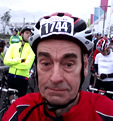I can't recall the exact time I decided to try riding the Etape du Tour 2014 from Pau to Hautacam in the Pyrenees, but it was sometime toward the back end of 2013. I'd applied to do the Maratona dles Dolomites in the ballot, and had been overlooked, so in a fit of pique, decided to do something different, knowing also that a mate of mine who is a member of the same club (shameless plug for Team Milton Keynes) was also planning to do it. I mean, I'd done Marmotte, Ventoux and the Quebrantahuesos (a wonderful Spanish epic), so how hard could it be? Besides which, like so many blokes, I needed a goal, otherwise I'd just descend further into cycling mediocrity.
As regards the Maratona, I have shot myself in the foot, as they don't allow anybody who is 65 years of age or over to do the full event - and I'm 64! I don't know whether to be gutted or relieved, to be honest - at least I have an ironclad excuse not to do it, though maybe I ought to attempt the climbs before I die. I would need to garner a huge stock of brownie points first, though...
Anyway, decision made. I was going to do this thing. The 2014 Etape du Tour followed the same course as stage 18 of the Tour de France, starting in Pau and taking in two monstrous Pyrenean mountains - the Tourmalet and a summit finish atop the Hatacam.
I signed up for a package with Sports Tours International which guaranteed me entry into the event and provided the usual airport transfers and a range of hotel accommodation. Flights were my responsibility, so I booked to go with Ryanair (God help me) from Stansted (ditto) to Biarritz, about an hour's coach transfer from Pau, which was where the hotel accommodation was and where the ride was due to start from.
Logistics
One key requirement of a ride like the Etape is a medical certificate confirming that you are physically fit enough to participate in bike rides. Without that, you cannot ride. I downloaded this and went to my local medical centre, expecting to have to make an appointment to see a doctor and have a physical examination. Nope. I presented it to the receptionist and got a phone call the next day to say that it had been completed and signed by the doctor. When I called by to collect it I was stung for £20, which I thought was a bit steep. The definition of money for old rope, but at least I had the damn thing. I suppose I should be flattered by the assumption that of COURSE I was fit enough.
Sports Tours International offered the option of transporting your bike, in a bike box, via lorry down to Pau and back again after the ride. I was immediately attracted to this, as there was no weight limit on the bike box, unlike an airline, and I reckoned the chances were better that the bike would survive intact as compared with leaving it to the tender mercies of baggage handlers at an airport. However, it still meant I had to disassemble the bike (which is large) and get it into the bike box. I've done this three times previously, but it never seems to get any easier. I always seem to do things in the wrong order, but I managed it eventually.
To effect the pick-up by the travel company, my mate Trevor and I (well, actually just Trevor - he offered to drive) decided to take the bikes up to the Birmingham drop-off point (other drop-off points were available). So one sunny Saturday afternoon, Trevor turned up in his large car and we went up to Birmingham with his and my bike boxes in the back.
The whole process was really very painless. We got there with no traffic holdups, handed our bike boxes over to the storage company, presented ID, signed a form, and wheeled our bike boxes into a storage cubicle which was then locked with a fearsome combination padlock. Then we went home. Simples. Far less stressful than checking it in at an airport, panicking whether it's below the weight limit and wondering if it will be in the same number of pieces at the other end.
The documentation provided by Sports Tours was pretty impressive and explained what needed to happen by when in some detail. In essence, Trevor and I were due to fly out to Biarritz on Friday, 18th July and get transferred to our hotels in Pau (we'd picked different ones, of which more later). Saturday was to be used to reunite you with your bike, rebuild it, cycle over to the registration place, register for the event, pick up your ride pack and goodie bags, then cycle back to your hotel, where you slept with your bike on the Saturday night (if you see what I mean). There was a Sports Tours rep at every hotel, who was to ensure that you were kept informed and help if there were any queries.
Then on the Sunday morning, you were to cycle to the start at your allotted time, do the ride, get back to the finishing village to collect your medal, cycle over to Sports Tours' meeting point, find your bike box, disassemble your bike again, pack it in the box for transport back to Birmingham, get on the coach, get taken back to your hotel, sleep the sleep of the just and knackered and get transported to Biarritz on the Monday to catch your flight back to Blighty. I have to report that all this happened, but not without incident...
Lead-up to the ride
Obviously, when you embark on any expedition of this nature, you have to pack. With a 15kg weight limit for the hold luggage, this had to be carefully planned, as we had been warned to be prepared for all weather conditions. I had been keeping a very close eye on the weather forecast for the region on the day of the ride, and it had been getting steadily worse. Couple this with all the paraphernalia that goes with cycling anyway, prioritising your selection of nutrition, electronic gadgets (very important, of course), chargers, etc., and it becomes a major exercise. Anyway, I made my decisions and weighed the case, having to tweak it to keep below the 15kg limit. I also had the option of cabin baggage, of course, but having fallen foul previously of Ryanair's restrictions on this, I kept it pretty small and light.
As usual with these things, time passes by quickly and suddenly you've got to go. Trevor arrived, I loaded my suitcase and cabin bag into his car and off we went to Stansted. The journey was uneventful, and Trevor had had the foresight to pre-book parking at the airport. Lo and behold, the number plate recognition technology worked and we were able to park within a short distance of the departure terminal.
We decided to check in immediately, and it was pretty obvious that there were many others whose intentions were the same - bike boxes everywhere. As I'm sure most of you know, the routine these days is to check in online, which I'd done, so why does one have to queue for so long at the check-in desk?
My turn. I put my suitcase on the check-in belt and it weighed 14.3 kg. I'd made the weight by 700 grams! Phew, that was close! Curiously, there seemed to be absolutely no restriction on either the size or weight of your cabin baggage, so Ryanair have obviously changed their regulations.
Next step, Security. Members of my immediate family will be well aware that I tend to screw up here - I've left something in my bag that I shouldn't have or there's something in my pockets that I should have put in the tray. Miraculously, after a VERY long wait in the queue, I sailed through with no hold-ups. Believe me, that was a result.
After this, the usual waiting around. Being long of leg, I'd priority booked a seat which offered decent legroom - worth every penny. The priority queue was called forward, we walked down the tunnel toward the aircraft, stopped at the end before we exited the tunnel - and were immediately called back "due to technical problems with the aircraft". My heart sank, as I'd experienced this before and we'd been delayed 48 hours... However, 5 minutes later, we all trooped onto the aircraft and eventually took off about 35 minutes behind schedule.
The flight was smooth and uneventful. We landed at Biarritz which is really quite a nice small airport and almost immediately made contact with the Sports Tours reps - couldn't really miss them in such a small area. Piled onto the coach and I was checking into my hotel about an hour later.
At this point, perhaps I should explain that Trevor and I had made separate plans re our accommodation. I had paid a premium to have a room on my own, and I'd selected a hotel which according to the spec provided by Sports Tours was 3-star on a bed and breakfast basis. My French is reasonable, so I was quite happy to go out in the evening to find a restaurant for my evening meal - indeed, that's part of the charm of France as far as I'm concerned. Trevor had selected a half-board package as his French, in his own words, was "non-existent". He also had to share the room with another male Etape participant - not for me, thanks. However, any superiority I might have felt vanished when I realised that the hotel I'd selected, the All Suites, was an aparthotel - a room with a kitchenette for you to do your own cooking, no bar and no other social area. Worse was to follow when I discovered that the nearest supermarket was a very unpleasant 25 minute walk away and the hotel was a 45 minute walk from the centre of Pau. No restaurants within 2 miles. Trevor had selected the Campanile in the centre of town, which offered a bar, a decent restaurant and the opportunity to socialise. Definitely a better choice.
Another weird thing about this establishment was the fact that the reception area closed at 8 p.m. and there was no emergency number. Entry to the room was via a swipe card, so what on earth happened if you lost your card and returned to the hotel after 8 p.m., I have no idea. I was not impressed.
I had to make the best of it, so I made my way to the supermarket and staggered back with some essential provisions (it's amazing how much those beer and wine bottles weigh...). One good thing about this place was the excellent free WiFi, so I connected to this and watched the re-run of the Tour de France stage on Eurosport.
We were due to be taken in by coach to a central point in Pau at 9.30 the following morning to reconstruct our bikes, so after a reasonable night's kip in a comfortable bed, I wandered down to breakfast in plenty of time. Breakfast was a poor quality buffet affair - nothing fresh or hot (apart from the coffee). It was obvious that I had badly blundered on my choice of accommodation.
I was reunited with my bike box with little trouble, followed by my usual struggle to put the contents back together again. I eventually succeeded and successfully negotiated my way on the bike to the Expo, which is where we had to register for the event. I eventually divined that we had to leave our bikes in a separate bike park before we were allowed in to register. This actually made sense, as the place was rammed with people.
I had the necessary paperwork with me - or so I thought. I'd downloaded what the website called a "convocation" - basically a confirmation that you were officially entered for the ride. However, in my case, it did not have a bib number printed on the form - I don't know why. Everybody else's did, so I didn't know which tent to go to for registration. There was an information point, so after an interminable wait whilst I was getting more and more stressed, I was finally seen by someone who spoke excellent English, identified me on the system and gave me that all-important bib number (9891). Phew!
I made my way to the appropriate tent and was presented with my ride pack. Next, I picked up my goodie bag, which turned out to be a surprisingly good quality rucksack with the usual commercial tat and yet another water bottle in it. Finally, I collected an official Etape T-shirt, also surprisingly good quality.
I had a quick wander around the Expo, which provided a huge variety of commercial operations with plenty of opportunity to empty your wallet, but all I really wanted was a coffee. No chance. I therefore decided I'd go back to the hotel to have some lunch and ready myself for the rigours of the following day.
On presenting the chit I'd been given when I'd deposited my bike at the bike park, my bike was returned to me, minus a water bottle (bidon) that was mission-critical. After a frantic search, it was located - it had fallen off when the bike had been parked. Again, phew!
Just as an aside here, I saw Martin Johnson, the ex-England rugby union captain, and his riding colleagues, all kitted up to do the ride, just outside the Expo. I don't know how he got on - huge power, but a massive frame to drag up the mountains to come.
I found my way back to the hotel with little trouble, aided by Google Maps, and carried my bike up two floors to my room. Here I affixed the number card which had the timing chip on it to the front of the bike and basically got everything as ready as I could. There was really nowhere to go for a quiet warm-up ride around there, so I just waited in the room until 6 p.m. when we were due to meet our Sports Tours rep who would provide us with some key information, i.e. our starting time.
As is usual with these big sportives, the start is in waves depending upon your bib number. The lower numbers were due to start earlier. There seemed absolutely no logic to the numbering system whatsoever, so I considered myself relatively lucky that I would be a late starter. I had to be in my pen by 7.45 a.m. at the latest for an 8.20 start - really quite civilised.
The rep also gave us a bag on which we had to write our bib number and fill with whatever we wanted to have available at the end of the ride, e.g. change of clothes, recovery drink, etc. This I duly did and, having prepared all the gubbins that you have to take with you - gels, sports drinks, rain jacket, energy bars, etc. - I retired at a reasonable hour and set the alarm for 6.15 a.m.
The Ride
I really didn't sleep very well, so when the alarm went off, I felt pretty ropey. Got togged up and went down to breakfast, but really couldn't force much down, as is usual for me before these types of events. The weather forecast was for lots of heavy showers, but right now it was mild and cloudy.
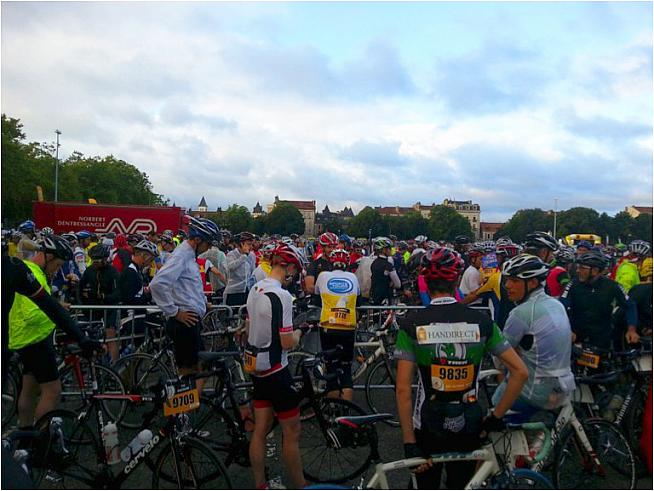
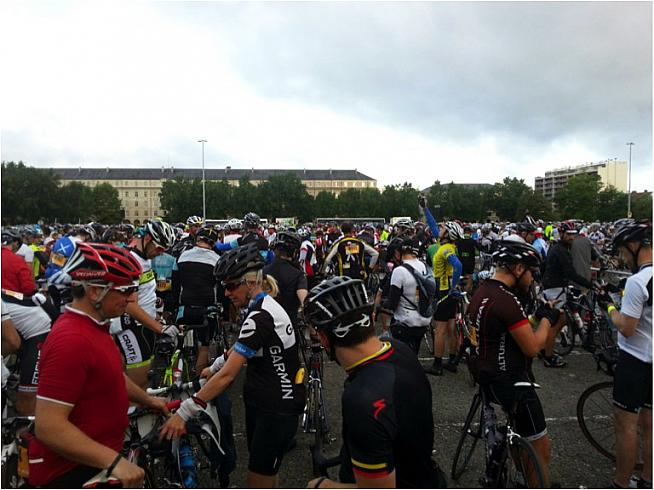
I left the hotel on the bike at around 7 a.m. - I am perpetually paranoid about being late. It was easy enough to find the starting point (Place du Verdun in Pau) and locate my pen. As I'd got there at around 7.20, I had an hour's wait, but far rather that than turning up in a muck sweat and risking not being allowed to ride. Loads and loads of cyclists everywhere - I believe about 10,000 actually started the event. I began to settle down and relax, and the temperature rose far enough that I took off my arm warmers. I also took a few pictures with my phone, including a selfie, with the intention of comparing how I looked at the start and at the finish.
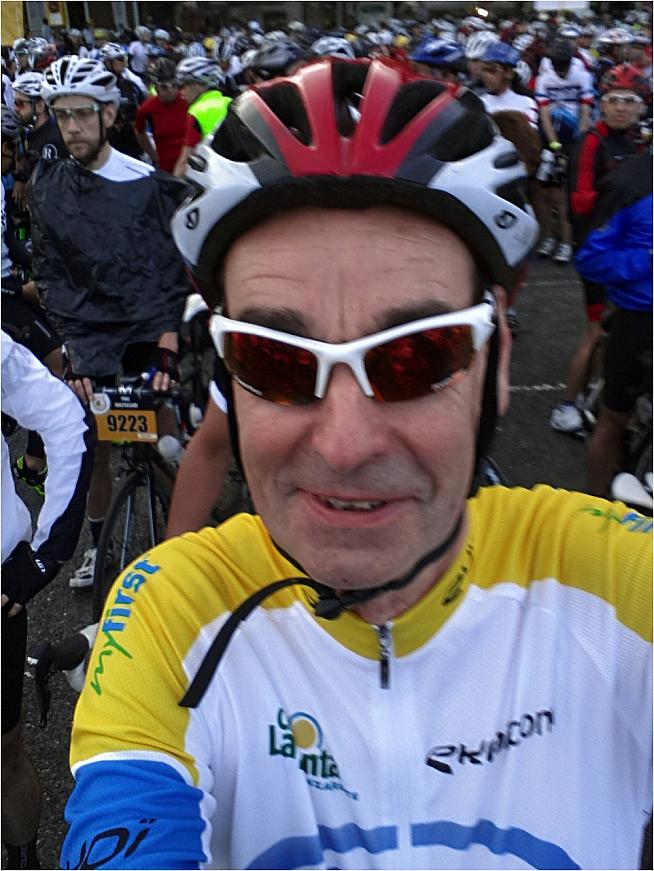
The atmosphere was brilliant, though I could have done without quite so much of the announcer screeching at high volume in French without appearing to draw breath. It was also very well organised. Every now and again we would edge forward, and I just tried to stay relaxed.
At almost exactly 8.20, I found myself pushing across the start line, clipping in (eventually) and starting the ride. I knew that I had to pace myself, so I deliberately didn't set out too fast, but before long we were bowling along at a fair old lick on flattish roads. I latched onto a few groups who appeared to be travelling at my sort of pace so as to save energy. Temperature was around 17 degrees and the winds were light - very nice cycling conditions.
There really wasn't much to report in the early stages, apart from the fact that after about 30 miles, it rained, so on went the rain jacket. Not long after that it stopped, so to avoid boil-in-the-bag syndrome, off came the jacket.
There were a few stiffish climbs, a couple of which are officially described in the stage of the Tour as Category 3, but really nothing too bad, serving as leg warmers for the monster that is the Col du Tourmalet.
As we entered the unlovely town of Bagneres de Bigorre, it began to rain - again. On went the rain jacket - again - and we began to ascend the lower slopes of the Col du Tourmalet.
Col du Tourmalet
To begin with, the Tourmalet really wasn't too bad. The official stats are that it is 2,115 metres high and the average gradient is 7.3%. Doesn't sound so bad, does it? However, the lower slopes are a perfectly reasonable 4-5%, which obviously implies that the slopes further up are somewhat steeper.
Oh, boy, can I confirm that. It is relentless. There are markers which tell you what the average gradient is for the next kilometre. Those gradients increased - all the way up. I kid you not. The weather was just getting worse - biblical rain, poor visibility as we were up in the clouds and you could not see any of the scenery that is supposed to make this such a great climb. The temperature was dropping also, just to add to the suffering. No false flats to recover. This, in my opinion, is a tougher climb than Alpe d'Huez. It sounds as though I am laying this on with a trowel, but it was a real ordeal. I was absolutely soaked to the skin and beginning to shiver. When I got to La Mongie, about 4 kilometres from the top, I simply had to stop, just to try to warm up and regain some semblance of mental fortitude. Sports Tours had a stand there and provided a branded bin-liner which I donned to try to insulate me from the rain and cold. I knew also that I had to make the descent, so any additional protection I could get was essential.
As you might expect, I'd taken a long time over this climb, so was anxious to get underway. I laboriously climbed the final 4 kilometres which took me, very slowly, over the top of the Tourmalet.
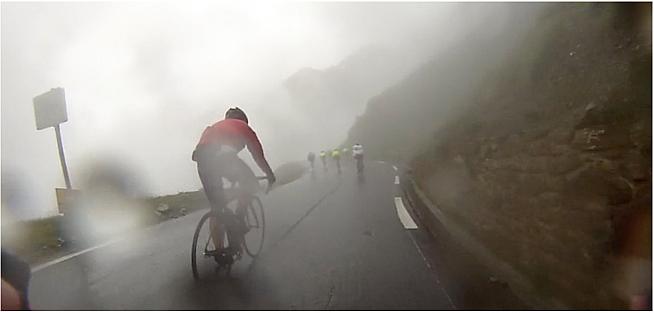
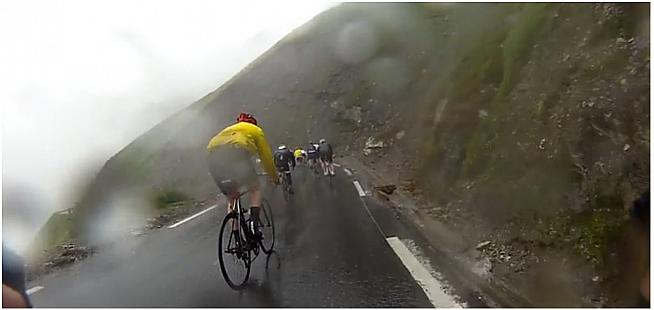
Next - the descent. I'd been looking forward to this as an opportunity to recover, because I really needed some recovery time. I'm not the greatest descender on the planet, but training camps I'd attended in Spain in the past had taught me a lot. However, this was a really tough experience. Visibility was extremely poor, my hands were freezing, so braking became an act of faith rather than any controlled operation. I had to keep my hands on the brakes pretty much the whole time as negotiating any sort of bend was fraught, it being slippery in places due to the huge quantities of water over the surface. I was shivering almost uncontrollably in temperatures of 6 degrees - I'm pretty certain that if I'd been stopped by any of the paramedics at this point, I would have been diagnosed with near-hypothermia and bundled into an ambulance. I saw plenty of that on the way down...
Mercifully, it started to warm up perceptibly as I descended. The conditions got slowly better, and by the time I'd come off the Tourmalet and was riding along the relatively flat bit between it and the Hautacam, life became a little more bearable. But it took my knees several minutes to get working properly, as they'd been frozen during their relative inaction on the way down. It was still raining, but not as intensively as it had been.
There was little else of any significance to report until we hit the lower slopes of the Hautacam. By this time, the rain had all but stopped. Funnily enough, despite all the suffering that had gone before, there was never any doubt in my mind that I was going to make the attempt. Recalling the event afterwards, Trevor said that he would not have tried if it hadn't been for the amazing support at the bottom.
The Hautacam
As with the Tourmalet, the lower slopes of the Hautacam were relatively modest. The climb is shorter, but on average marginally steeper (7.4%).
I'd been warned that the Hautacam would be tougher than the Tourmalet. I'm not sure about that, but it was certainly different. The weather wasn't such a factor, and unlike the Tourmalet, there were a few areas of false flats where you could coast for some blessed recovery, but it meant that some of the climbing was absolutely brutal. As with the Tourmalet, there were markers advertising the average gradient for the next kilometre. These figures increased to a maximum of 11.3% fairly near the top and there were ramps of 20% in places. Monstrous.
I just got my head down and got on with it - very slowly. There were loads of people walking at this point, which actually made life difficult at times, as people had to move over to pass them and were therefore moving into the very slow and wobbly stream of cyclists. This was made even worse by the fact that the road was coned off down the middle to separate those that were climbing and those descending. In fact, I heard later that there had been some serious injuries when a descender hit a climber who had wobbled across to the other side of the road - it really was a very dangerous situation and not at all enjoyable.
As I made my way up, the average gradient finally began to decrease and I knew that I was going to make it. Finally I reached the 1 km to go sign and, to my dismay, I could see switchbacks up the side of the mountain full of cyclists. SURELY that was more than a kilometre? It looked a LOT further than that...
Anyway, I made it. The actual finish of the ride was another 500 metres or so further on, so I cycled through it and managed to stagger off my bike. By this time, the sun had actually come out, but I just felt relief that it was over. The picture below sums it all up - I look as though I've aged 20 years...
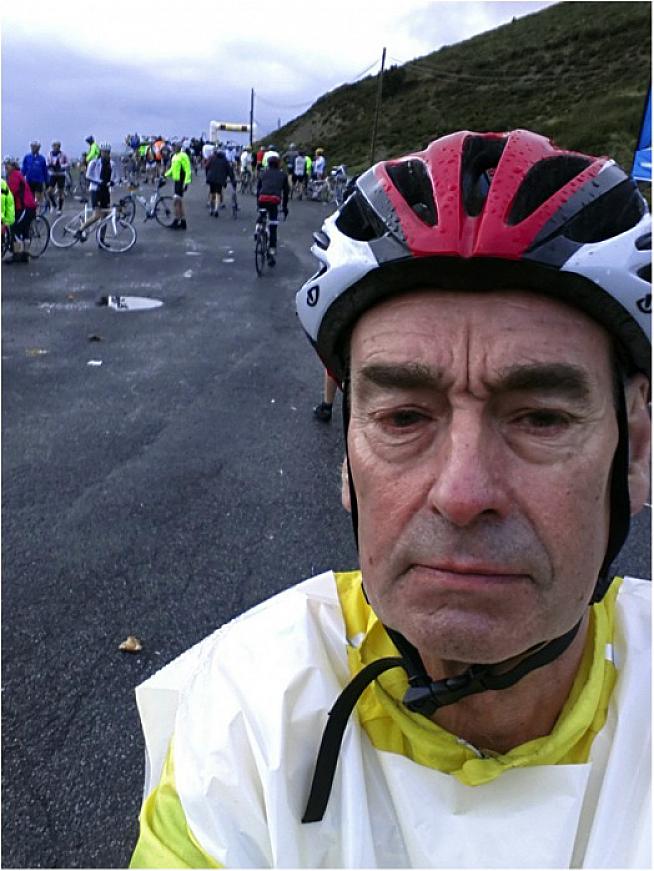
Having forced down a very dry cheese sandwich, it began to rain again. I was faced with the descent of the Hautacam back to the finishing village now, so I wearily climbed back on my bike and started down. By this time the number of ascenders had reduced to a trickle, so the dangers I had seen on the way up were mitigated considerably. In fact, I believe they had stopped people from ascending somewhat earlier for safety and time reasons. This wasn't as bad as the descent of the Tourmalet, but again I began to shiver and lose feeling in my hands.
There had been a significant lack of directions from Sports Tours International at the top of the Hautacam as to where we had to go when we got to the bottom, and I was casting around frantically for some guidance when I arrived. Fortunately, I saw a Sports Tours rep at a junction on the roundabout, and she directed me to the finishing village. I started along the lane toward it and, at this point, I punctured! Would you believe it! After all I'd been through, at least I'd not suffered any mechanicals until now.
I was therefore faced with walking to the finishing village to get my medal, which was a good half-mile away. It doesn't sound far, but when you are cold, wet, and near the end of your mental tether, it's a bloody long way, also bearing in mind that I had to walk back to find the Sports Tours assembly place. I was certainly in no physical and mental condition to mend a puncture.
Medal obtained, I started to make my way back. There was no verification at the medal collecting - anybody could have just walked in and got one, which rather devalued it. I finally made it to the Sports Tours meeting point, where I was reunited (eventually) with my bike box and faced with the thoroughly unedifying prospect of dismantling my bike to fit inside it, with cold hands and completely knackered, both physically and mentally.
I was also reunited with the kitbag that Sports Tours had provided containing clothes, food, etc., but it took a while to find it - there seemed to be no system in place. I managed to get the bike into the box and get changed into something drier. I dropped the bike off at the lorry destined to take it back to Birmingham and wearily climbed onto the coach which was due to take us back to our hotels.
I had sit and wait quite a while, but eventually the coach filled up, the coach driver's brief apparently being to drop everybody off at their hotels. The fact that these numbered about 12 did not cause him to turn a hair, but it turned out to be the coach journey from hell. The journey back from the finishing village to Pau was uneventful enough, even though it began to rain again. The nightmare began when the driver, who spoke very little English, had to explain to tired cyclists where their hotels were - it was pitch-black at this time and some riders had no idea of their hotel location. One gentleman was getting particularly agitated as he was accompanied by a diabetic partner who was in dire need of food. Some riders also had their bikes packed onto the coach, so they had to get their bikes out of the coach storage, adding to the delay and frustration. Apparently a van was supposed to be following the coach with some of the riders' bikes on board - this never materialised and one rider refused to get off the coach step until he'd received assurances that his bike would be delivered to his hotel. At one point, to everybody's total mystification, the coach driver, having dropped someone off, drove forward about 200 yards, then reversed about half a mile! The fact that no one knew what was going on just made matters worse.
I was at Hotel 10 out of 12, and I knew exactly where it was, so my being dropped off, along with a few others, was relatively stress-free. Because of this weird security system at the hotel, a password had to be entered at the gate. Fortunately, somebody remembered it and I could make my way to my room, finally crawling into bed at around 11.45 p.m. It was just as well that I had my room entry card, otherwise I would have been completely stranded.
Last day
After the toils, sturm und drang of the previous days, this went relatively smoothly. After the final plastic breakfast, we loaded onto the coach to take us back to Biarritz at around 11.30 a.m. The usual interminable waiting around at the airport (my hold baggage was down to around 12.5 kg as I'd packed more into my cabin bag), then through Security (again without incident - miracle), then boarded the plane without fuss. We were probably the only flight that afternoon, so we took off on time and landed at Stansted ahead of schedule.
The usual irritation of collecting baggage and going through Security had to be put up with, but fairly soon we were on our way back home in Trevor's car - the bikes, of course, were undergoing a separate journey to Birmingham. We had some traffic to contend with, but nothing serious. Trevor dropped me off, we shook hands, I walked up my drive and he drove home. All a bit anti-climactic, really.
Final thoughts
I can, of course, take great satisfaction that I finished the Etape. However, the climbs were a real ordeal, much of it to do with dreadful weather conditions. The organisation of the ride left something to be desired, as did the package operators. I wish I could say that I enjoyed it, but I can't. I compare it with my experience at the Quebrantahuesos in Spain the previous year in wonderful sunshine and with great organisation from Train in Spain, and it's like chalk and cheese.
Further irritation was to follow when I discovered that my video camera had packed up by the time I approached the finish, so I have no record of the finish apart from one "selfie". However, I have the medal and the inner knowledge that I made it against very considerable odds.
The whole experience has made me re-evaluate my thought processes on doing these epic climbs. Having done the extent of Alpine and Pyrenean climbing that I now have, I feel I have nothing to prove, to myself or anybody else, so I probably won't do any more.
Only... It's the 50th anniversary of Tom Simpson's death on the slopes of Mont Ventoux in 2017. Surely it'll be fun to do Ventoux again then?
We'll see.
4 Comments

